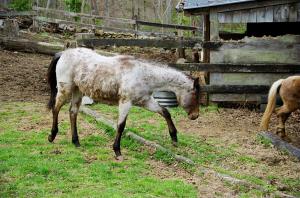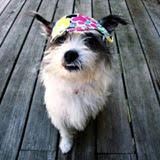By Sandy Rakowitz
This is a case study I wrote up a few years ago about Roulette, an 11 month old PMU Filly.
Background:
Roulette was born on a PMU Farm** in Alberta, May 7, 2006. She is out of a Quarter horse mare. Roulette was one of the foals that was due to go to slaughter. (** For more info on what is the horrible practices that create PMU foals see the end of the article)
The Animali Farm in California*** somehow organized getting 100 foals adopted all over the USA by the first of Dec. ’06. While awaiting transport, Roulette lived in a feed lot from December 2006-March 2007. She arrived in Virginia on March 25th in a big rig along with a bunch of other rescued foals. She was totally wild and completely freaked out when she arrived at my friend Catherine’s Farm in Middleburg, VA.
Catherine is an experienced horsewoman. Yet with 3 weeks of gentle and patient care Catherine said she was feeling a bit concerned because the filly’s progress was extremely slow.
I happened to be staying with Catherine while I was assisting at the Middleburg, VA TTEAM training in April ’07. While I was visiting I worked with Roulette 3 times for about 20-30 minutes at a time.
When I met Roulette, she was highly reactive and high headed. After 3 weeks, Catherine was still unable to touch her head, she could not touch her body without the filly jumping and being startled. She could not touch her legs without her flinching, pawing and moving away and she would kick out at times. She was fearful of halters and ropes. Catherine had been unable to halter her or do any basic care like grooming, picking up her feet, trim her hooves or handle her.
Prior to my arrival Catherine had been stroking the filly with a stick which she said had been helpful. But she was dismayed at her very slow progress and was wondering how she was going to be able to get a halter on her or if she would be able to get to her feet to be able to trim them.
Day 1; 4-17-07
Roulette bolted into the stall from the paddock along with her very small pony companion to eat her dinner. Once she began eating her dinner, she calmed down. She had very high head carriage and her movement was very unrefined meaning she could not take small steps and her movement was jolted rather than smooth. The whites of her eyes were showing. Her coat was very matted. She looked like a small wooly mammoth.
She had not had anyone handle her besides Catherine in the last 3 weeks since her arrival. She was surprisingly fine with me, a stranger, walking into her stall. I used a 4’ stiff Wand to quietly stroke her with the wand off of her body with no direct contact. I followed the contours of her body all the way down to her hooves. I used the wand through the air about 4 feet from her to see how she would respond. She accepted this easily.
Slowly I moved closer and closer to her physically. Within a few minutes, I was able to stroke directly on her body. I started at her chest without so much as a flick of the ear. She remained calm, her breathing even and deepening while her eye began to soften as I continued stroking. I gradually stroked all over her body, adding in a second wand for additional sensory information. With a steady rhythm, I stroked down the underside of her neck, down her chest, and continued down her legs to her hooves. I stroked along her back, sides, belly, over her hindquarters, down her back legs, and over and down her tail. Catherine was amazed I could do so much so quickly and that the filly remained so calm and with a softening eye. This serves to ground, calm and also helps to ‘map’ the body. The horse gets a better sense of their own body and where it is!
I used the wand to begin making TTouch circles on her chest with the length of the wand. After a minute or so of this, I switched one wand around and began to use the butt end of the wand to make TTouch circles all over her body as well. The stroking and the circles had a calming and grounding effect.
I spoke with Catherine about overriding the instinctual reactive patterns by doing this long, firm, steady stroking. I also spoke about the balancing of brain wave patterns that has been shown through our recent studies in EEG’s.
After a few minutes, I worked my way down one of the wands with my hand. As I was doing a circle with the wand I was also gradually moving my hand down the 2nd wand until my hand was in direct contact with her body. With one wand holding steady on her back, I continued doing LLama TTouches with my free hand directly on her body. So far, this was all on the right side of her body as this is the direction she was facing while she was eating her dinner.
Working in this manner I held a clear intention that my hand and the wand to be one, there seems to be little the wand was an extension of my hand. I have consistently found that those who have been fearful of physical contact are much more readily accepting when I begin with stroking off the body and gradually work my way on to the body with the wand, then I continue with my hand gradually moving onto the body continuing with the circles. I have used this technique with horses, dogs and cats.
Once I began TTouches on her body, I began with Llama TTouches using the back of my hand. This is much less threatening than an open palm. I was able to work along her shoulder, neck and her back. She was extremely tight in these areas.
I did a few minutes of Llama TTouches, and then went back to stroking with a wand 4-5 times along her body. I did this in about a 5 or 6 minute time frame. I was able to work right up to her poll by using these combinations.. Catherine was amazed! Roulette then turned to me for the first time, curious and interested. I felt honored at her change in trust. She reached to touch my hand. Catherine was again amazed since Roulette had never let her get close to her poll nor had she reached out to Catherine in this manner previously.
After she ate, she quietly walked around the stall. I squatted and turned sideways to her to make myself less threatening. She approached me several times, smelling, looking, and curious. I just allowed her to investigate me on her own terms, letting her choose how much contact she wanted with me, and did not reach towards her at all. Her eye was very, very soft. This really seemed to captivate her attention, this human squatting down, not ‘doing’ anything.
I was able to then slowly stand upright and move towards her. I was able to begin stroking her left side which Catherine had not been able to work very much. She was more uneasy on the left side. Even though she was no longer eating her dinner to hold her attention she settled easily and allowed me to stroke her with the wand all over her back, legs, and chest from this side.
Once I began stroking her with a wand and doing circles with the wand on her body, I was easily able to shift to doing some Llama TTouches, Clouded Leopard circles, and Abalone Circles along with Coiled Pythons with my hands directly along her shoulder, back and hind end. These are all variations of TTouches that gently help to bring awareness, release pain and tension, help to release the memory of pain, and have a calming effect.
She was extremely tight through her back and hind end. I stroked a bit more, and finished for the day. Altogether, this took about 20 minutes. She was very quiet, with her head about level to her withers by the end.
Catherine and I later spoke about the variety of things that I was doing that was different than what she had previously done with Roulette:
• Stroking with a wand instead of a stick. A wand is softer, more pliable and can follow the contours of the body. It is great that she was stroking her though.
• Stroking her first, before trying to touch her with my physical hand.
• I also added some essential oils blends (Trauma Life, Valor and Sara) to the tip of the wand. As I stoked the oils also were stroked onto her body to further assist her relaxing, balancing and releasing of fear held in the cells.
• I added a second wand for additional grounding and sensory information.
• I added various TTouches with the wand and then directly on the body.
In the picture below Roulette is walking calmly with her head down into her stall the day after her first TTouch session. No more bolting into the stall for food!

** “Premarin is a drug prescribed to women to treat the symptoms of menopause. It is made from Pregnant Mare’s Urine. The PMU industry is primarily based in Canada, and is manufactured by an American owned company. For many years it has been one of the most widely prescribed drugs in the country. Canadian Equine Ranchers have been collecting Pregnant Mare’s Urine since the 10940’s. A “Premarin Horse” is any horse that has been used in this industry. Mares that stood in the collection barns are called Premarin Mares, and their babies, PMU foals.”
This horrific practice continues. Info from a quick google search: “The estrogen-replacement drug Premarin, prescribed to menopausal women, is made from horse urine; in fact, the drug’s name is short for PREgnant MARes’ urINe. About 750,000 mares are impregnated each year for the sole purpose of collecting their estrogen-rich urine.
Some of the thousands of foals born on PMU farms each year are used to replace their exhausted mothers. Some are offered for adoption, but the remaining foals—along with worn-out mares—are sold at auction, where most are purchased by buyers for slaughterhouses.” Roulette was one of the lucky ones to find her way to the United States, and into my friend’s barn.
***The Animali Farm is a non-profit horse rescue that works with ranches transitioning out of the PMU business (Pregnant Mare Urine). They find homes for horses that would otherwise go to auction or sometimes slaughter. Please see www.animalifarm.com for more information.
Set up a Zoom Session with Sandy to help you work with your horses. www.onehearthealingcenter.com
Roulette continued to make wonderful progress after her first day of TTouch. Come on back to read more about her amazing progress.
Sandy
Copyright 2009

Leave a Reply